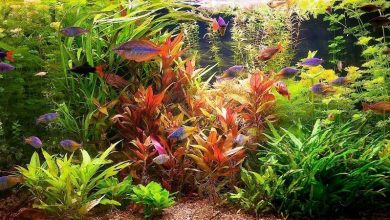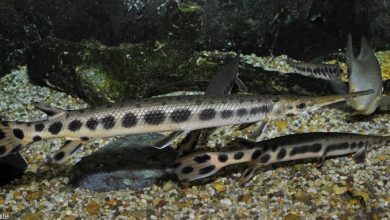Neon Fish, Neon Tetra


- Scientific name: Paracheirodon innesi, Hyphessobrycon innesi
- Common Name: Neon Fish, Neon Tetra
- Aquarium size: 60 liters
- Temperament: Calm
- Temperature: Between 21º and 28ºC
- pH: Between 4 and 7.5
- Diet: Omnivores
- Length: 4 cms
Description
The Neon fish, Neon tetra or Neon Innesi , is a warm and fresh water fish of the Characid family , they are related to the famous piranhas, and with the also known Tetra Cardenal or Neon Cardinal . Not to be confused with the Chinese neon fish , which is from the Cyprinidae family, and is a cold-water neon fish.
It is a fish that is not too easy to reproduce in the aquarium, although not impossible.
At present, it is a very popular fish since professionals have managed to overcome the problem of captive reproduction and many of these fish are produced, greatly reducing the price of neon fish.
To its price, you have to add something that is obvious and that aquarium lovers appreciate, it is a fish that adapts well to living with other species, it is not very demanding on water quality and it is very resistant , which makes a variety of fish suitable for anyone who wants to get started in the aquarium world.
Morphology
The neon fish or neon tetra, is a fairly small fish, usually measuring about 4 centimeters . They have an elongated shape, with a rounded nose.
Its coloration is formed by an intense blue or greenish-blue lateral stripe, with a red spot on the ventral part of the fish.
With these color changes, it is not uncommon for you to occasionally come across statements such as Red Neon Fish, Blue Neon Fish or Copper Neon Fish… they actually refer to the same Neon Tetra, but at different times and colors.
This strip is less noticeable in black water, it seems that it would be a natural protection against predators. Neon fish
are known to change the intensity of their coloring, becoming lighter in conditions of substrate or lighter background, and more opaque and with a more purplish side stripe at night.
It is supposed to be a natural response, with the intention of making them less visible to their predators.
Sexual dimorphism
There is no evident sexual dimorphism, except that females tend to be somewhat rounder and larger than males. It is quite difficult to tell the difference between one and the other.
Distribution and habitat
Although the origin of the neon fish is not too clear, it has been proven that geographically there are several areas of location, one would be around Leticia, Colombia and Brazil.
A second area, in which populations of paracheirodon innesi have also been found, is a few hundred kilometers to the east, in the Amazon, Brazil and the Purus River, a tributary of the Amazon at the mouth of Codajás.
Additional populations have also been sighted in western Brazil, eastern Peru, and southeastern Colombia.
Its natural habitat is the minor currents of main river channels.They are acidic and soft waters, usually stained brown, due to the presence of decomposing organic matter. But this is not always the case, because some populations live in transparent waters.
Ideas for setting up your aquarium
- Best complete aquariums
- Best Small Aquarium
- Best external filters for aquarium
- Best aquarium heater
- Best Aquarium Oxygenator
- Best Aquarium LED Display
- Better sand
- Best substrate for aquarium
- Best compost for plants
- Best Aquarium Stones
- Best aquarium logs
- Best Aquarius Test
- Best Ph meter
- Best fish food
- Best Fish Food Dispenser
Aquarium conditions
Neon fish do not need an aquarium that is too large, 50 or 60 liters is enough . The water must be kept at a temperature ranging between 21º and 28ºC , with a pH between 4 and 7.5, the hardness can be set at 18-215 ppm.
The aquarium decoration should comprise a sandy and dark substrate or, in which some roots and branches of floating wood should be included. It is not necessary to add natural peat, which is more difficult to maintain and will make the aquarium dirty.
You could add some dry leaves or floating plants to the aquarium , which will provide a greater feeling of naturalness.
Although we place plants and trunks, among which they can seek shelter, it is convenient to leave the center of the aquarium clear, so that they find free spaces in which to swim.
They are most comfortable with dim lighting . The plant species that we are going to include in the aquarium must be able to withstand this situation.

Diet
What does the Neon fish eat?… It is recommended to give them small amounts of food, spaced three times a day.
They are omnivorous fish, which can eat dry food without problems. The diet should be supplemented with Daphnia, Moina or tubifex larvae (mosquito larvae).
If we want, we can supplement their diet with lettuce leaves and other vegetables.
It is important that the size of the pieces is small, we are dealing with a very small fish, the size of the food has to be consistent.
Behavior and compatibility
The neon tetra is a sociable and gregarious fish , so that they are in the best conditions, it is convenient to add between 8 and 10 fish, in which males and females are included. The feeling will be more natural.
It can be combined with other characins of similar or smaller size, it will share its space well with cichlids that are not predators or catorish loricarids.
Neon Fish Compatible Fish
Fish compatible with Tetra Neon fish without restrictions
- Botia Clown
- Mosquito fish
- Otocinclus
- Drunk Fish
- Rainbow
- Guppy
- Barbel Cherry
- Corydoras
- Ramirezi
- Rasbora Galaxy
Compatible fish without restrictions
- Ancistrus
- Monjita Fish
- Zebra fish
- Female betta
- Harlequin fish
- Telescope Fish
- Snail Apple
- Gourami Pearl
- Kribensis Cichlid
- Ax fish
Compatible fish without restrictions
- Chinese Neon
- Tiger Barbel
- Molly fish
- Comet Goldfish
- Guppy endler
- Platy Fish
Restricted Compatible Fish
- Scalar Fish
- Koi carp
- Paradise Fish
- Killis fish
- Discus fish
- Silver Dollar Fish
Reproduction
Although raising neons is not easy, it is possible, as long as certain conditions are recreated.
- A breeding aquarium should be set up , which should be dimly lit and contain thin-leaved plants, to offer them a place to lay their eggs.
- It is convenient to cover the bottom of the aquarium with some type of mesh, which allows the eggs to pass through, but prevents the adult fish from having access to them, so that they cannot eat them.
- The water conditions must be modified . We must look for a temperature of about 27ºC, with a pH 5.5-6.5.
- For reproduction, we can place a group of males and females, although better results are obtained if we can put a male neon fish and a female neon fish.
- When we believe that the females are full of eggs (pregnant neon fish), we transfer the male to the tank. We will look for the fattest one with the brightest colors. It should be done overnight.
- They should spawn the next morning, and see eggs within two days. Remove the adult tetra once we have evidence of spawning.
- The eggs hatch between 24 and 36 hours after laying, and we will be able to see fry after 3 or 4 days.
- The fry are very sensitive to light, if possible, keep the tank in the dark.
Tips
The innesi neon that we buy in hot water fish stores is usually bred in captivity, although it is possible to buy neon tetra online , with which we can get species caught in the wild.
In these cases, it is possible that they offer us a paracheirodon innesi gold or platinum , which are differentiated by their coloration. This difference is caused by a parasite, which stimulates the increase of guanine in the scales, but it is really the same specimen.
Neon fish diseases
Neon fish are prone to so-called white spot disease .
This disease is contracted by fish through the mouth, they excavate the walls of the intestine and later enter the muscles of the fish, produci





